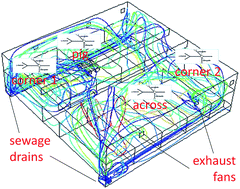Rapid monitoring of the spreads of porcine reproductive and respiratory syndrome virus (PRRSV) was attempted using samples collected from nasal swabs of pigs and air samplers within an experimental swine building. An optofluidic device containing liquid-core waveguides was used to detect forward Mie light scattering caused by the agglutination of anti-PRRSV-conjugated submicron particles, with enhanced sensitivity, signal reproducibility, and reusability (reusable up to 75 assays). These results were compared with reverse transcription polymerase chain reaction (RT-PCR) assays (35 cycles) and showed excellent agreements to them. Each assay took less than 10 min including all necessary sample pre-processing, while the RT-PCR assays took up to 4 h including sample pre-processing and gel imaging for PCR products. A 3-D computational fluid dynamics (CFD) simulation was utilized to track the transport and distribution of PRRSV (from the mouths of pigs to the exhaust fans) within a swine building, and compared with the readings from an optofluidic device. Simulation results corresponded well with the experimental data, validating our 3-D CFD model for the spread of viral pathogens in a livestock environment. The developed optofluidic device and 3-D CFD model can serve as a good model for monitoring the spread of influenza A (swine and avian) within animal and human environments.

You have access to this article
 Please wait while we load your content...
Something went wrong. Try again?
Please wait while we load your content...
Something went wrong. Try again?


 Please wait while we load your content...
Please wait while we load your content...